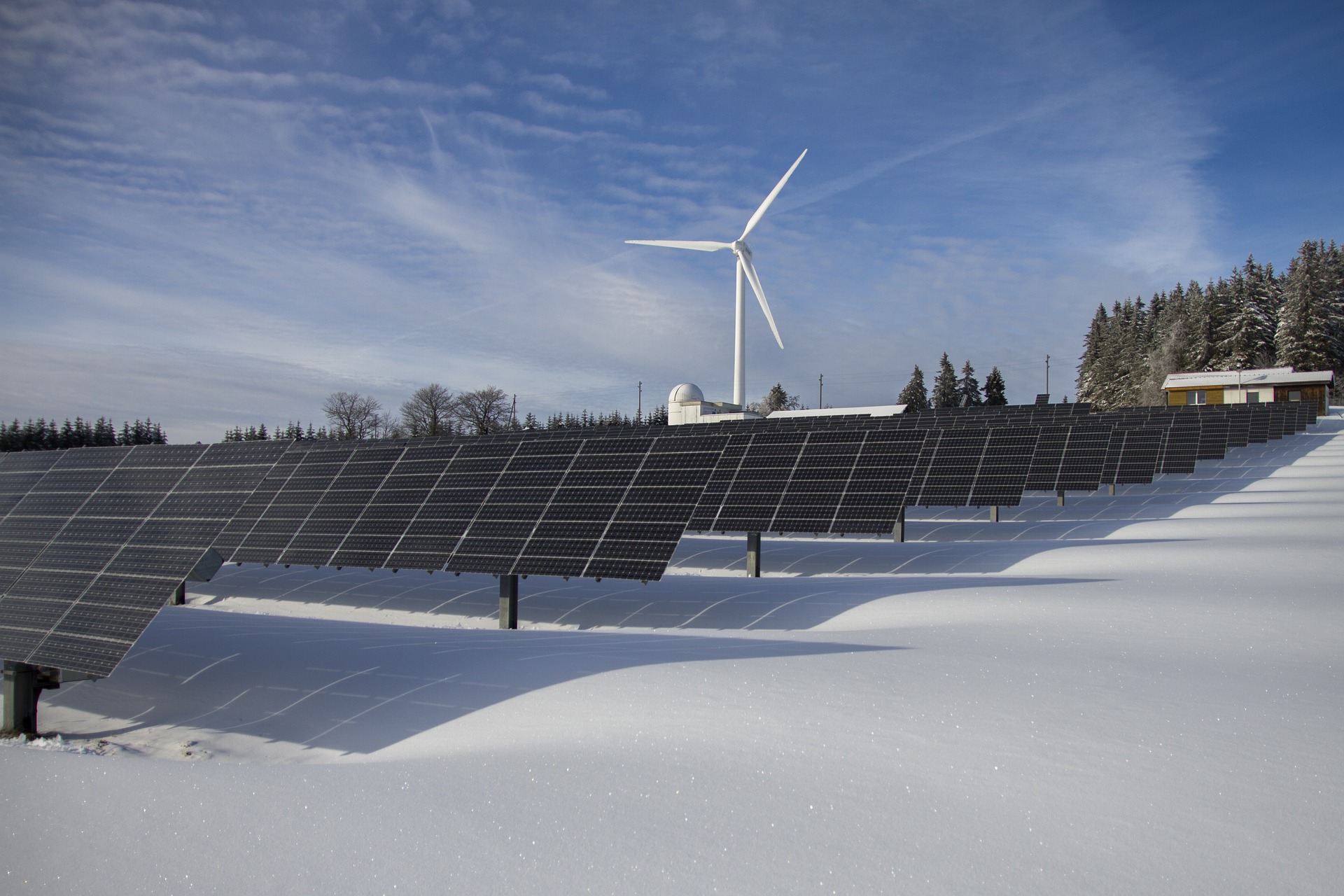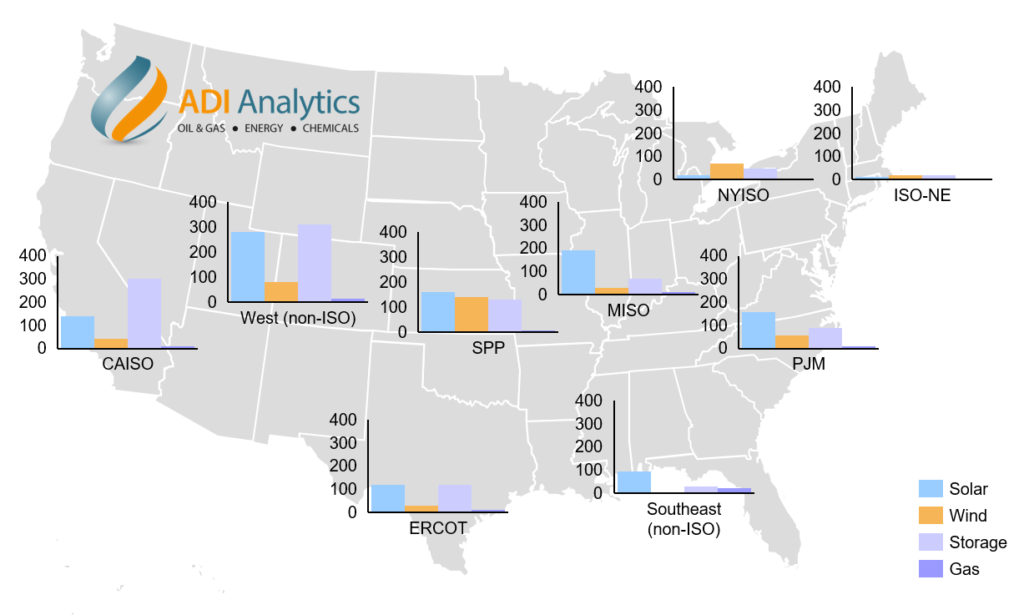
The clean energy revolution is upon us, and the U.S. grid is feeling the growing pains. A staggering 2,600 gigawatts (GW) of renewable energy projects, primarily solar and wind, are lined up waiting to connect to the grid . This clean energy tsunami is more than double the existing generating capacity in the U.S., signifying a strong shift towards low-carbon power. The Inflation Reduction Act of 2022, with its incentives for clean energy development, likely serves as a major driver behind this surge.
California leads the pack with nearly 450 GW of renewable energy projects in its interconnection queue, followed closely by Texas, illustrated in Exhibit 1 and Exhibit 2. Interestingly, the top five states with the most clean energy waiting to connect contribute to over half of the total demand. But here’s the rub: while the desire for clean energy is strong, the process to connect these projects to the grid is agonizingly slow. On average, it takes a project between 3 to almost 6 years to navigate the studies and permitting needed before construction can even begin. This significant wait time acts as a major hurdle in the clean energy transition.

Exhibit 1. Proposed project capacity seeking interconnection to grid by state
(GW, as of the end of 2023)

Exhibit 2. Proposed project capacity seeking interconnection to grid by region
(GW, as of the end of 2023)
There’s a silver lining, though. The Inflation Reduction Act designated certain areas as “energy communities,” offering additional tax credits for renewable projects. Data shows that over 580 GW of the waiting renewable energy falls within these designated areas, particularly in states like New Mexico and Texas. This additional incentive could push these projects forward despite the delays.
Overall, the data paints a picture of a nation enthusiastically embracing clean energy. However, streamlining the connection process is absolutely crucial to accelerate this transition and achieve our climate goals.
FERC steps up, but is it enough?
In July 2023, the Federal Energy Regulatory Commission (FERC) recently took action via Order 2023 to address the interconnection backlog with a new set of rules. These reforms aim to improve efficiency and expedite the process. Here’s a breakdown of the key changes:
- Prioritizing the ready: The old system functioned like a slow-moving queue, prioritizing projects based on their application date. FERC’s new approach prioritizes projects that are most prepared to connect quickly, adopting a “first-ready, first-served” mentality. This rewards developers who have completed their planning and secured necessary permits.
- Standardization and deadlines: FERC’s reforms introduce standardized procedures across the nation, aiming to eliminate regional inconsistencies. Additionally, stricter deadlines are imposed on transmission providers to hold them accountable for completing interconnection studies in a timely manner.
- Embracing new technologies: The new rules pave the way for easier integration of innovative technologies and hybrid resources like solar-plus-storage projects. This allows for a more flexible and adaptable grid system.
While these changes represent a positive step forward, some experts believe they might not be enough to fully address the current interconnection challenges. Let’s delve deeper into the root causes of the backlog.
The root of the gridlock: outdated system, maxed-out capacity, and under-resourced operators
The slow pace of clean energy integration stems from several fundamental issues:
- Outdated interconnection process: The current interconnection process was designed for a bygone era with far fewer generators seeking grid access. It’s simply not equipped to handle the current influx of clean energy projects.
- Grid capacity constraints: Our transmission system is operating at near capacity, and upgrades are happening at a glacial pace. These expansions often fail to consider the massive clean energy projects waiting to connect. The current approach leaves the burden of building necessary infrastructure on individual projects, which is an inefficient and piecemeal approach.
- Understaffed grid operators: Grid operators are struggling with limited resources, including a lack of qualified staff and outdated study software. This makes it difficult to keep pace with the ever-growing number of interconnection requests. The lack of readily available and accurate grid hosting capacity data further exacerbates the situation. Developers, left in the dark about potential network upgrade costs, often submit multiple queue entries in a desperate attempt to find the most cost-effective connection point. This not only increases the initial workload but also leads to unnecessary dropouts and re-studies later.
Short-term solutions include investing new technologies and talent
There are some immediate actions that grid operators can take to address these challenges:
- Deploying grid-enhancing technologies (GETs): Utilizing GETs can help maximize the available capacity on the existing grid system. FERC’s order already mandates transmission providers to consider certain GETs as part of interconnection studies.
- Streamlining existing infrastructure connections: For projects that utilize existing interconnection infrastructure and rights, developing streamlined interconnection study processes can expedite approvals.
- Modernizing tools and staffing up: Upgrading study software and investing in recruiting and retaining qualified staff at grid operators are crucial steps towards a more efficient system.
Long-term policy ideas such as learning from ERCOT’s “Connect and Manage” approach
The Electric Reliability Council of Texas (ERCOT) offers a unique case study in interconnection processes. Unlike the traditional “invest and connect” approach used in most regions, ERCOT employs a method called “connect and manage.” Here’s how it works:
- Prioritizing connection: ERCOT focuses on local upgrades necessary to connect a project to the grid. Bottlenecks are then managed through market mechanisms, such as curtailment or redispatch of existing generation. This approach is faster and less expensive compared to requiring expensive, upfront transmission upgrades for every project.
- Proven success: ERCOT’s method has yielded impressive results. In the last two years, they were able to integrate a staggering 14.2 GW of renewable energy, significantly more than any other grid operator in the US. Additionally, their interconnection process takes only 1-2 years, compared to the national average of 3-6 years or even longer in some regions.
While ERCOT’s approach demonstrates the potential benefits of a less restrictive interconnection process, it’s important to acknowledge some limitations:
- Unique characteristics: ERCOT functions as an energy-only market, a characteristic not shared by all grid operators. This unique structure may contribute to the success of their “connect and manage” approach, which might not be universally applicable.
- Planning and stability concerns: Managing grid stability and ensuring adequate transmission capacity for future needs are crucial considerations. A more flexible interconnection approach needs to be balanced with long-term planning to avoid compromising reliability.
FERC could explore mandating transmission providers to offer a new option for energy-only resources. This option could be similar to ERCOT’s Energy Reliability Service (ERIS), which allows generators to connect to the grid without full delivery guarantees under stressed conditions.
Overall, ERCOT’s experience serves as a strong case study for exploring alternative interconnection approaches. While challenges exist, a more flexible system, coupled with strategic planning, could significantly accelerate the clean energy transition.
Conclusion
The clean energy revolution is upon us, and the need for a modernized grid to accommodate this surge is undeniable. FERC’s recent reforms represent a step in the right direction, but a multi-pronged approach is needed to address the backlog and expedite clean energy integration. Implementing short-term solutions like deploying GETs and streamlining existing infrastructure connections can provide immediate relief. Long-term solutions require a paradigm shift, potentially inspired by models like ERCOT’s “connect and manage” approach. By embracing innovation, investing in grid infrastructure, and fostering a more flexible interconnection process, we can pave the way for a clean energy future powered by a robust and efficient grid.
– Uday Turaga and Bhautik Gajera
ADI Analytics is a prestigious, boutique consulting firm specializing in oil & gas, energy transition, power, and chemicals since 2009. We bring deep, first-rate expertise in a broad range of markets including electric utilities, digital automation in energy, and energy management, where we support Fortune 500, mid-sized and early-stage companies, and investors with consulting services, research reports, and data and analytics, with the goal of delivering actionable outcomes to help our clients achieve tangible results.
We also host the ADI Forum, one of Houston’s distinguished industry conferences, to bring c-suite executives from oil & gas, energy transition, and chemicals together for meaningful dialogue and strategic insights across the value chains.
Subscribe to our newsletter or contact us to learn more.



















